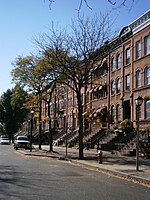West Side Avenue station

West Side Avenue is a station on the Hudson–Bergen Light Rail (HBLR) in the West Side neighborhood in Jersey City, Hudson County, New Jersey. Located on the east side of West Side Avenue, the station is the terminal of the West Side Avenue branch of the Hudson–Bergen Light Rail, with service to Tonnelle Avenue station in North Bergen. The station consists of a single island platform and a pair of tracks that end at the station. The station contains a pedestrian bridge over West Side Avenue to a small parking lot and bus stop on the west side of the street. The station is accessible for handicapped people per the Americans with Disabilities Act of 1990, with an elevator in the pedestrian overpass and train-level platforms. West Side Avenue station opened on April 17, 2000 as part of the original operating segment of the Hudson–Bergen Light Rail.
Excerpt from the Wikipedia article West Side Avenue station (License: CC BY-SA 3.0, Authors, Images).West Side Avenue station
West Side Avenue, Jersey City
Geographical coordinates (GPS) Address Nearby Places Show on map
Geographical coordinates (GPS)
| Latitude | Longitude |
|---|---|
| N 40.7146 ° | E -74.0873 ° |
Address
West Side Avenue
West Side Avenue
07304 Jersey City
New Jersey, United States
Open on Google Maps




